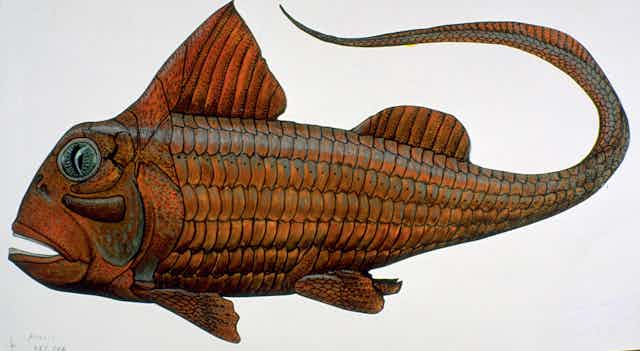Fossilised soft tissues, such as skin and muscle, are exceptionally hard to come by. When you think the chances of an animal being fossilised is less than one in a million - and these usually have only bone preserved - the chances of us finding a fossilised animal, complete with preserved muscles, are very low indeed.
So it’s no surprise previous work piecing together the musculature of extinct species involved trying to reconstruct those muscles using scars on the surface of the fossilised bones - until now.
The fish from the Gogo Formation, a 380-million-year-old sedimentary deposit in the remote Kimberley area of Western Australia, are preserved in 3D as original bone. Previous work by my colleagues and I found small amounts of soft tissue on these fossils.
But our recent fossilised discovery - published in Science today - was particularly outstanding. It revealed complete sets of multiple muscles allowing the complete restoration of the major muscles of the neck and trunk in ancient armoured fish: placoderms.

Muscly placoderms
Placoderms are the most primitive of the jawed vertebrates, but our discovery revealed these primitive fishes had a far more complex soft anatomy then previously thought.
They had a hinged joint between the head and the trunk armour, which helped raise the head. A set of muscles to elevate the head had been predicted from studying muscle attachment scars left on the bones and on functional morphology, but instead of having only one set of head elevators, we discovered two sets.
In addition to these, the cucullaris muscle, which depresses the head, was also identified. This muscle occurs in all vertebrates with jaws, including ourselves, but this was the first time its presence has been confirmed in our earliest jawed ancestors.
The most unexpected discovery was a set of abdominal muscles. Living sharks and bony fishes have metamerically segmented muscles (which comprise repeating segments) running the length of their body; however, placoderms have a set of specialised, crosswise (transverse) abdominal muscles, unique in fishes.
The exact function of these muscles is not known, but it is possible that these were to stop shear forces between the body armour and the tail while swimming. Previously, abdominal muscles, which run in a transverse direction, have only been recovered from tetrapods (animals with four legs).

Looking at (and through) the fossils
Two specialised tomographic techniques - synchrotron and conventional micro-computerised tomography (micro-CT) - were employed to examine the delicate preserved musculature.
Synchrotron and micro-CT are non-invasive ways to take sectional images through 3D structures, so we were able to build pictures without taking the fossils away from the supporting rock matrix.
The European Synchrotron Radiation Facility in Grenoble, France showed one of the branchial muscles, which we were unable to see from external examination of the fish. The micro-CT scanner at ANU revealed tendons within the skin of the placoderm, arranged in much the same way as in modern sharks.

In addition, some specimens were painstakingly prepared in acid baths at ANU. This is a extremely delicate procedure because acid normally dissolves delicate muscle tissue. But, once the rock matrix was removed, the bone and remarkably the muscles of the neck were revealed.
The muscles are mineralised as calcium phosphate. In some cases, each individual muscle cell had been replaced by a single apatite crystal resulting in the detailed replication of the muscle. In others, preservation was not so detailed but individual muscles fibres could still be traced.
Why it matters
Obviously, the evolution of jaws in fishes required major changes not only in the skeleton, but also the muscles.
The occurrence of such extensive amounts of muscle tissue was never expected in fossils that are 380 million years old. This discovery highlights the importance of fossil sites with exceptional preservation in understanding the morphology of extinct animals.
In addition, the use of non-destructive tomographic techniques is revealing anatomy that previously could not be determined, as it could not be visualised. The musculature revealed in these primitive fishes demonstrates a level of complexity never predicted.
We have shown that the cucullaris muscle has been conserved through vertebrate evolution, confirmed for the first time in the most primitive jawed fishes and still present in humans today.

